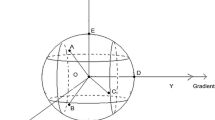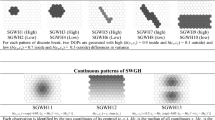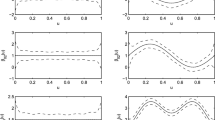Abstract
This paper develops a method to capture anisotropic spatial autocorrelation in the context of the simultaneous autoregressive model. Standard isotropic models assume that spatial correlation is a homogeneous function of distance. This assumption, however, is oversimplified if spatial dependence changes with direction. We thus propose a local anisotropic approach based on non-linear scale-space image processing. We illustrate the methodology by using data on single-family house transactions in Lucas County, Ohio. The empirical results suggest that the anisotropic modeling technique can reduce both in-sample and out-of-sample forecast errors. Moreover, it can easily be applied to other spatial econometric functional and kernel forms.








Similar content being viewed by others
Notes
Other kernel forms include the negative exponential kernel (Dubin 1988), the Gaussian kernel, and so on. Thorsnes and McMillen (1998) use a semiparametric estimator to analyze the relationship between land values and parcel size in a sample of 158 undeveloped parcels in Portland, Oregon. They find that implementing the alternative kernels Gaussian, Epanechnikov, Quartic Triangular, and Uniform gives very similar results.
See the numerical example in the Appendix 1 for detailed calculation steps.
The distance in this study is calculated as the straight line between the latitude and longitude using the distance formula for the rectangular plane coordinate system. This is because, for a neighborhood, a spherical angle is negligible. In addition, we require only an approximate relative distance.
Detailed calculation steps can be found in the numerical example in the Appendix 1.
The numerical example in the Appendix 1 is obtained under this situation.
The value depends on the spatial structure in the dataset. In our data, a value of 135 m fits the data best. Compared with other values, the anisotropic approach can best enhance the fitness of the model.
We use up to two times the nearest neighbors (i.e. 4/20 nearest neighbors in our case) to calculate the gradient, because in the anisotropic approach the final nearest 2/10 neighbors are selected from the nearest 4/20 neighbors, see Appendix 1. In doing so, we include all potential neighbors to calculate the gradient.
Because we iterate twice and use different neighborhoods in each iteration step to measure the gradient (i.e. a smaller neighborhood in the first run and a larger one in the second run), we have two parameter b: b1 in the first iteration and b2 in the second.
The optimal b1 and b2 are selected by iterating the procedure in the given range from 1 to 50 for b1 and from 1 to 12 for b2 and comparing the log-likelihood value.
When building the ISAR model we referred to the Spatial Econometrics Library by LeSage.
The isotropic Kriging method has been applied on housing price spatial correlation analyses by many studies, see Dubin (1998); Basu and Thibodeau (1998); Gillen et al. (2001); Bourassa et al. (2007). Differently with the spatial econometric approach, which defines the spatial autocorrelation by spatial weight matrix, the Kriging method derives the correlation by semivariogram.
Reference
Bao, H. X. H., & Wan, A. T. K. (2004). On the use of spline smoothing in estimating hedonic housing price models: empirical evidence using Hong Kong data. Real Estate Economics, 32(3), 487–507.
Basu, S., & Thibodeau, T. G. (1998). Analysis of spatial autocorrelation in house prices. Journal of Real Estate Finance and Economics, 17(1), 61–85.
Bourassa, S. C., Cantoni, E., & Hoesli, M. (2007). Spatial dependence, housing submarkets, and house price prediction. Journal of Real Estate Finance and Economics, 35(2), 143–160.
Bowen, W. M., Mikelbank, B. A., & Prestegaard, D. M. (2001). Theoretical and empirical considerations regarding space in hedonic housing price model applications. Growth and Change, 32(4), 466–490.
Can, A. (1992). Specification and estimation of hedonic housing price models. Regional Science and Urban Economics, 22, 453–474.
Colwell, P. F., & Munneke, H. J. (2009). Directional land value gradients. Journal of Real Estate Finance and Economics, 39(1), doi:10.1007/s11146-007-9104-0.
Dubin, R. A. (1988). Estimation of regression coefficients in the presence of spatially autocorrelated error terms. Review of Economics and Statistics, 70, 446–474.
Dubin, R. A. (1998). Predicting house prices using multiple listing data. Journal of Real Estate Finance and Economics, 17(1), 35–59.
Gillen, K., Thibodeau, T. G., & Wachter, S. (2001). Anisotropic autocorrelation in house prices. Journal of Real Estate Finance and Economics, 23(1), 5–30.
Granger, C. W. J., & Newbold, P. (1977). Forecasting economic time series. New York: Academic.
LeSage, J. P. (1999). Spatial Econometrics. http://www.spatial-econometrics.com/html/wbook.pdf.
LeSage, J. P., & Pace, R. K. (2004). Models for spatially dependent missing data. Journal of Real Estate Finance and Economics, 29(2), 233–254.
Pace, R. K., & Gilley, O. W. (1997). Using the spatial configuration of the data to improve estimation. Journal of Real Estate Finance and Economics, 14(3), 333–340.
Pace, R. K., & Gilley, O. W. (1998). Generalizing the OLS and grid estimators. Real Estate Economics, 26(2), 331–347.
Thorsnes, P., & McMillen, D. P. (1998). Land value and parcel size: a semiparametric analysis. Journal of Real Estate Finance and Economics, 17(3), 233–244.
Valente, J., Wu, S., Gelfand, A. E., & Sirmans, C. F. (2005). Apartment rent prediction using spatial modeling. Journal of Real Estate Research, 27(1), 105–136.
Weickert, J. (1996). Anisotropic diffusion in image processing. Stuttgart: Teibner-Verlag.
Weickert, J. (1997). A review of non-linear diffusion filtering. In B. ter Haar Romeny, et al. (Eds.), Scale-space theory in computer vision, lecture notes in computer science (pp. 3–28). Berlin: Springer.
Wilcoxon, F. (1945). Individual comparisons by ranking methods. Biometrics, 1, 80–83.
Acknowledgements
The authors are grateful to James P. Lesage for allowing us to use the transaction data from Lucas County, Ohio. We would also like to thank Joachim Zietz, Klaus Uhlenbruck, and the anonymous referee for useful suggestions and helpful comments on previous versions of the paper. This manuscript has also benefited from the comments by participants at Immobilien- Forschungssymposium, EBS, 2008; ARES 2009 conference. We bear responsibility for any remaining errors.
Author information
Authors and Affiliations
Corresponding author
Appendix 1 Numerical example of anisotropic neighborhood definition
Appendix 1 Numerical example of anisotropic neighborhood definition
Using the properties in Fig. 8 as examples, we illustrate here how to construct an anisotropic neighborhood. The center property A has latitude and longitude of (49.665556, −83.5686870).
Table 5 shows the latitude, longitude, and spatial trends \( \hat \varepsilon \left( {{s_i}} \right) \) of property A and the nearest twenty properties. When defining an isotropic neighborhood, we must first use latitudes and longitudes to calculate the straight line distances under the geodetic coordinate system from each of the twenty properties to property A (Table 7, column 3). These properties are then sorted by ascending distance (Table 7, column 2) and we construct the isotropic neighborhood by using the ten nearest properties within a range of 0.027 (c.a. 2500 m), i.e., properties 1 to 10 (identified in Fig. 8a). The following steps show how to construct an anisotropic neighborhood.
Gradient Estimation
We first calculate the two-dimensional gradient from the nearest twenty properties to property A using Eq. 5. Table 2a shows spatial changes Δε Aj , distance vectors \( \Delta {{\overset{\lower0.5em\hbox{$\smash{\scriptscriptstyle\rightharpoonup}$}}{D}}_{Aj}} \), and the estimated gradients. For example, the gradient from property A to property A1 can be calculated as follows:
The difference between the two longitudes is 0.000341 (about 20 m). Because of the small distance the gradient is unusually large while the spatial condition is unlikely to exhibit large changes. If the difference in latitude or longitude is less than 0.0015 (about 135 m) we set the gradient equal to zero; hence, \( \nabla {\overset{\lower0.5em\hbox{$\smash{\scriptscriptstyle\rightharpoonup}$}}{\rho }}\left( {{s_{A1}}} \right) = \left[ {\begin{array}{*{20}{c}} { - 5.419533} \\ 0 \\ \end{array} } \right]. \) The 20 estimated gradient vectors are in Table 6.
Using Eq. 6, the gradient at location S A is calculated as the average gradient of the nearest neighbor properties:
as in Fig. 8b. The strength of \( \nabla {\overset{\lower0.5em\hbox{$\smash{\scriptscriptstyle\rightharpoonup}$}}{\rho }}({s_A}) \) is \( \left| {\nabla {\overset{\lower0.5em\hbox{$\smash{\scriptscriptstyle\rightharpoonup}$}}{\rho }}({s_A})} \right| = \sqrt {{{( - 26.8191)}^2} + {{53.0670}^2}} = 65.373 \). We can represent the direction of \( \nabla {\overset{\lower0.5em\hbox{$\smash{\scriptscriptstyle\rightharpoonup}$}}{\rho }}({s_A}) \) as a unit vector \( {{\overset{\lower0.5em\hbox{$\smash{\scriptscriptstyle\rightharpoonup}$}}{\tau }}_u} = \frac{{\nabla {\overset{\lower0.5em\hbox{$\smash{\scriptscriptstyle\rightharpoonup}$}}{\rho }}}}{{\left| {\nabla {\overset{\lower0.5em\hbox{$\smash{\scriptscriptstyle\rightharpoonup}$}}{\rho }}\left( {{s_A}} \right)} \right|}} = \left[ {\begin{array}{*{20}{c}} {\frac{{ - 26.8191}}{{65.373}}} \\ {\frac{{53.0670}}{{65.373}}} \\ \end{array} } \right] = \left[ {\begin{array}{*{20}{c}} { - 0.43184} \\ {0.90195} \\ \end{array} } \right] \), and the perpendicular direction as \( {{\overset{\lower0.5em\hbox{$\smash{\scriptscriptstyle\rightharpoonup}$}}{\tau }}_v} = \left[ {\begin{array}{*{20}{c}} { - 0.90195} \\ { - 0.43184} \\ \end{array} } \right] \).
Coordinate Transformation
We can define the shrinkage rate φ as a function of the gradient strength using Eq. 9. For b = 2.5, the shrinkage rate φ for property A is given as \( \varphi = {1 \mathord{\left/{\vphantom {1 {\sqrt {{{1 + 65.373} \mathord{\left/{\vphantom {{1 + 65.373} {2.5}}} \right.} {2.5}}} = 0.192}}} \right.} {\sqrt {{{1 + 65.373} \mathord{\left/{\vphantom {{1 + 65.373} {2.5}}} \right.} {2.5}}} = 0.192}} \). When \( {{\overset{\lower0.5em\hbox{$\smash{\scriptscriptstyle\rightharpoonup}$}}{\tau }}_u} \), \( {{\overset{\lower0.5em\hbox{$\smash{\scriptscriptstyle\rightharpoonup}$}}{\tau }}_v} \), and φ are known, the distances in the local transformed coordinate system can be calculated using Eq. 8. For example, the new distance between properties A and A1 can be calculated as:
Similarly, the distance between properties A and A2 can be recalculated as:
The new distances between the twenty properties and property A under the local coordinate system are given in Table 7, column 5. Comparing the distances under both the geodetic and the local coordinate system, we can observe ordering changes. For example, property 17 is the seventeenth nearest property to property A under the geodetic coordinate system, but it ranks sixth under the local coordinate system.
For the local coordinate system, we can calculate range R′, to determine which properties make up the revised neighborhood, as follows: \( R\prime = R\varphi = 0.027 \times 0.192 = 0.005184 \). In this case, the nearest ten properties under both the geodetic coordinate system and transformed local coordinate system are with their own range (0.027 and 0.005184, respectively). So ten properties are chosen by both isotropic and anisotropic approach, but they are different ten properties.
Rights and permissions
About this article
Cite this article
Zhu, B., Füss, R. & Rottke, N.B. The Predictive Power of Anisotropic Spatial Correlation Modeling in Housing Prices. J Real Estate Finan Econ 42, 542–565 (2011). https://doi.org/10.1007/s11146-009-9209-8
Published:
Issue Date:
DOI: https://doi.org/10.1007/s11146-009-9209-8




